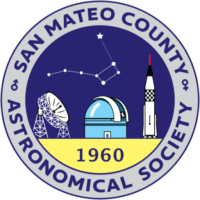Greetings to the Society,
Here’s to a New Year and New Adventures!
2024 was an incredible year for astronomical events. Many members experienced the awe-inspiring total solar eclipse on April 8, 2024, with some traveling to witness this rare celestial phenomenon firsthand. Closer to home, parts of the Bay Area were treated to a dazzling display of the Aurora Borealis or Northern Lights, as increased solar activity illuminated the sky with vibrant colors.
One of the year’s most exciting events was Comet C/2023 A3 (Tsuchinshan-ATLAS), which became visible to the naked eye. The comet delighted observers with its bright coma and a spectacularly long tail, creating unforgettable moments for skywatchers.
However, not every anticipated event occurred. We are still waiting for the much-anticipated nova event involving T Coronae Borealis (Blaze Star). Expected to erupt in 2024, the Blaze Star has remained quiet, leaving us hopeful that 2025 will bring this remarkable celestial event to fruition.
January
Early January provides a captivating display for stargazers and astrophotographers, beginning with a breathtaking alignment of the crescent Moon and Venus on January 3rd. Low in the western sky shortly after sunset, this pairing offers a stunning opportunity to capture the beauty of our celestial neighbors against a twilight backdrop.
The Moon continues its journey, drawing closer to Saturn by January 4th. This striking conjunction, visible around 5:00 PM PST, brings the two celestial bodies into remarkable proximity, creating a mesmerizing scene in the night sky. Observers worldwide can enjoy this pairing, with Saturn’s rings and the Moon’s craters offering a delightful target for telescopes and binoculars.
As the month progresses, the celestial drama intensifies with the arrival of the Wolf Moon on January 13th. This first full moon of 2025 brings a spectacular occultation of Mars. Observers in San Mateo can watch as Mars vanishes behind the Moon at 5:58 PM PST, reappearing about 50 minutes later—a truly unforgettable sight.
Adding to the excitement, comet C/2024 G3 (ATLAS) might grace the skies around the same time. As the comet approaches its closest point to Earth, it has the potential to become visible to the naked eye. While its brightness remains unpredictable, this celestial visitor offers another reason to keep your telescope at the ready and revel in January’s astronomical wonders.
February: The SPHEREx Launch
In February 2025, NASA plans to launch the Spectro-Photometer for the History of the Universe, Epoch of Reionization and Ices Explorer, or SPHEREx, observatory. This mission will survey the sky in near-infrared light, which is a type of light that is invisible to the naked eye but that special instruments can detect. Near-infrared light is useful for observing objects that are too cool or too distant to be seen in visible light.
SPHEREx will create a comprehensive map of the universe by surveying and collecting data on more than 450 million galaxies along with over 100 million stars in the Milky Way. Astronomers will use this data to answer big questions about the origins of galaxies and the distribution of water and organic molecules in stellar nurseries – where stars are born from gas and dust.
Don’t Forget the Holiday Party
Although there’s no meeting in January, don’t miss our Annual Holiday Party on January 18th, 2025! Details have been sent via email, so check your inbox for more information.
Looking Forward to Clear Skies
As we look ahead, let’s hope for clear skies to enhance our viewing of the many celestial wonders coming our way. Here’s to a year full of stargazing adventures and discoveries.
Clear skies and happy viewing!

Michael Cooke
President, San Mateo County Astronomical Society
